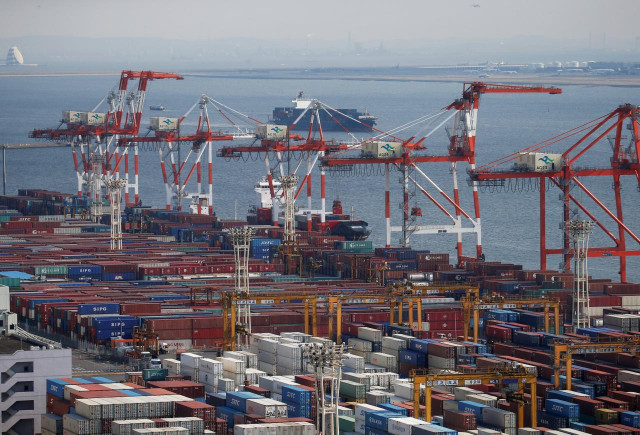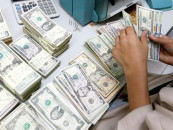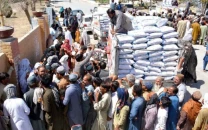In domestic demand-led growth, govt fails to focus on exports
This development strategy alone could not be sustained for a long period of time

Shipping containers are seen at a port in Tokyo, Japan, March 22, 2017. PHOTO: REUTERS
On this basis, Pakistan has been witnessing a domestic demand-led growth strategy over the last four years and the growth rate increases to 5% in 2016-17.
There is a certain kind of planning required to implement this development strategy. The foremost pillar in this regard is the access to and availability of fairly priced development finance. If financing for development is not readily and cheaply available, this strategy may fail.
APTMA hails terms of revised export package
In order to make the strategy successful, a lower middle-income country like Pakistan needs debt relief. Pakistan got the last debt relief in the early 2000s due to its engagement in the war against terror.
We know that such debt reliefs are a remote possibility when international circumstances are normal or geopolitics is not in play.
Another possibility is the foreign aid which brings precious dollars to be used wisely. In the past, foreign aid could not be translated into development purpose. On this basis, the foreign countries are not ready to pour dollars into Pakistan.
Last but not the least, the role of Official Development Assistance. In this regard, multilateral institutions may play a significant role in providing much-needed development finance. Specifically, the role of the International Monetary Fund (IMF) is the key.
The IMF may increase the quota of Special Drawing Rights (SDRs) so that a lower middle-income country can achieve its development objectives. Under the Extended Fund Facility (EFF), the provision of raising SDRs is there along with certain waivers. However, the government could not exploit this possibility to the fullest, though it got certain waivers at frequent intervals.
Media commentators and analysts criticise those waivers by saying that the IMF is quite lenient to the Pakistani government. These commentators equate the IMF loans to commercial ones which actually is not the case.
Export package termed short-term solution
Now the question is whether the domestic demand-led growth strategy is sustainable or not? The answer seems negative.
This development strategy is not well-planned since the government has either directly borrowed from commercial banks or from international capital markets in the form of Eurobonds and Sukuk. These commercial borrowings are not fairly priced and are quite expensive for a dollar-scarce country like Pakistan.
Another problem with this strategy is that it has been implemented at the cost of export-led strategy. The evidence is that exports declined from $25 billion in 2013-14 to $21 billion in 2016-17. On the other hand, imports have started to increase at a fast pace.
As a result, the component of net exports (exports minus imports) becomes highly negative. In following a domestic demand-led strategy, the government did not pay attention to the export sector.
The lesson of history is that developing countries who followed the domestic demand-led growth strategy alone could not sustain it for a long period of time. Although there remains expansionary domestic demand for a short time period say three to four years, the economy comes down to knees due to the deteriorating net exports.
In a nutshell, the government should follow a balanced and sustainable development strategy where domestic demand should complement the net exports. Both these components of GDP should reinforce each other.
Boosting exports Legislators stress modern techniques
The government has started to pay attention to the export sector after the EFF as exports provide precious foreign exchange to finance imports. This shift in strategy could bode well for the economy provided the government pursues it in a robust manner.
The writer is the Assistant Professor of Economics at SDSB, Lahore University of Management Sciences (LUMS)
Published in The Express Tribune, October 16th, 2017.
Like Business on Facebook, follow @TribuneBiz on Twitter to stay informed and join in the conversation.



















COMMENTS
Comments are moderated and generally will be posted if they are on-topic and not abusive.
For more information, please see our Comments FAQ